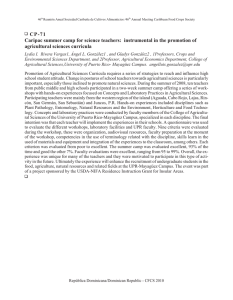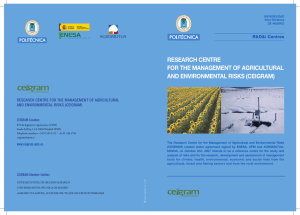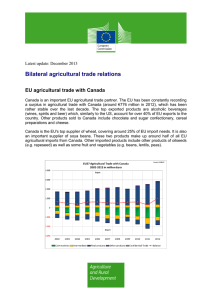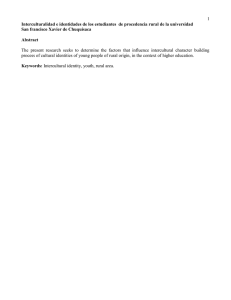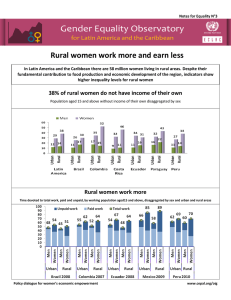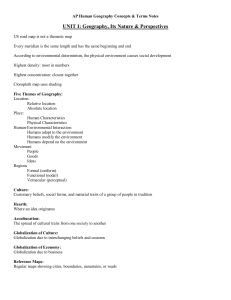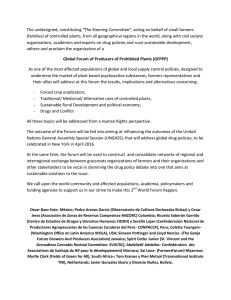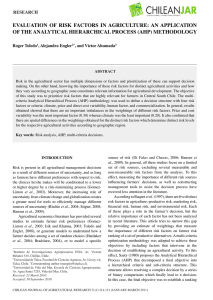en en draft report - European Parliament
Anuncio
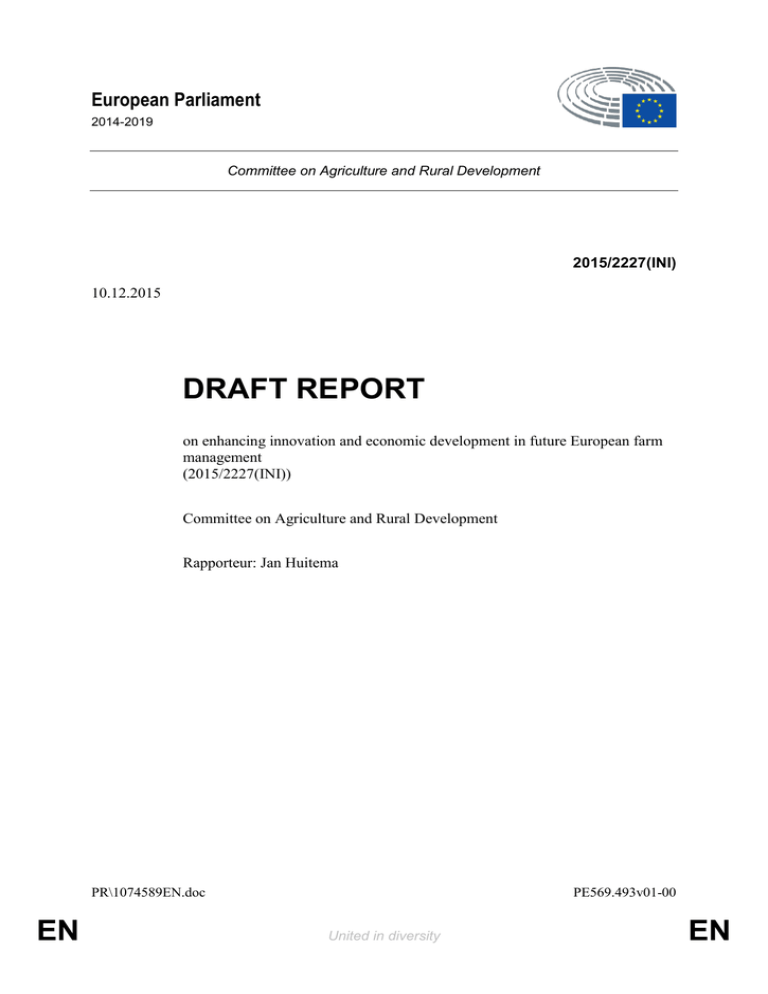
European Parliament 2014-2019 Committee on Agriculture and Rural Development 2015/2227(INI) 10.12.2015 DRAFT REPORT on enhancing innovation and economic development in future European farm management (2015/2227(INI)) Committee on Agriculture and Rural Development Rapporteur: Jan Huitema PR\1074589EN.doc EN PE569.493v01-00 United in diversity EN PR_INI CONTENTS Page MOTION FOR A EUROPEAN PARLIAMENT RESOLUTION ............................................ 3 EXPLANATORY STATEMENT............................................................................................ 10 PE569.493v01-00 EN 2/11 PR\1074589EN.doc MOTION FOR A EUROPEAN PARLIAMENT RESOLUTION on enhancing innovation and economic development in future European farm management (2015/2227(INI)) The European Parliament, – having regard to Regulation (EU) No 1307/2013 of the European Parliament and of the Council of 17 December 2013 establishing rules for direct payments to farmers under support schemes within the framework of the common agricultural policy and repealing Council Regulation (EC) No 637/2008 and Council Regulation (EC) No 73/2009, – having regard to Regulation (EU) No 1306/2013 of the European Parliament and of the Council of 17 December 2013 on the financing, management and monitoring of the common agricultural policy and repealing Council Regulations (EEC) No 352/78, (EC) No 165/94, (EC) No 2799/98, (EC) No 814/2000, (EC) No 1290/2005 and (EC) No 485/2008, – having regard to Regulation (EU) No 1305/2013 of the European Parliament and of the Council of 17 December 2013 on support for rural development by the European Agricultural Fund for Rural Development (EAFRD) and repealing Council Regulation (EC) No 1698/2005, – having regard to the memorandum of understanding between the European Commission and the European Investment Bank (EIB) signed on 14 July 2014, – having regard to its resolution of 2 October 2015 , – having regard to Rule 52 of its Rules of Procedure, – having regard to the report of the Committee on Agriculture and Rural Development and the opinion of the Committee on the Environment, Public Health and Food Safety (A8-0000/2015), A. whereas the UN’s Food and Agriculture Organisation (FAO) estimates that the expected rise in the world’s population to 9.1 billion by 2050 will require a 60 % increase in food production and a 24 % increase in crop yields in the developed countries by that date; whereas the FAO also estimates that there will be only a 4.3 % increase in arable land by 2050; B. whereas according to the UN, if the sustainable development goals (SDGs) are to be achieved agricultural productivity will have to double by 2030, while simultaneously the agri-food sector will have to adapt to climate change and changing weather conditions and improve ecosystem and soil quality; whereas four out of the eight UN Millennium Development Goals (MDGs) are connected to agriculture; C. whereas population growth, higher average incomes and changing consumer behaviour will lead to revised dietary preferences, in particular resulting in higher demand for processed foods and animal proteins such as meat and dairy; PR\1074589EN.doc 3/11 PE569.493v01-00 EN D. whereas despite the numerous challenges and the growing number of standards farmers have to deal with, EU consumers have never spent a smaller percentage of their income on food; E. whereas consumers are demanding food production with higher environmental standards and nutritional value, while the agricultural sector needs to diversify and innovate to provide good and affordable food for all; F. whereas owing to pressure on natural resources, climate change, the scarcity of land, the vulnerability of the environment, the growth of the world population and changing consumer behaviour, it is essential that farmers produce more with less, meaning a smaller ecological footprint per kg of product produced; G. whereas, a more productive and resource-efficient agriculture is key to addressing the challenges of sustainability for all farms of whatever size and to making them better equipped to preserve natural resources; H. whereas the EU is the biggest exporter of agricultural products worldwide, making the agri-food sector a key economic pillar of the Union employing 47 million people in 15 million downstream enterprises in fields such as food processing, retail and services, and contributing to a positive trade balance of EUR 17 802 euro that represents 7.2% of total value of EU exports; I. whereas the competitiveness of the common agricultural policy (CAP) is mentioned as one of the key goals in Article 4(a) of Regulation (EU) No 1305/2013, and increasing productivity and ensuring reasonable prices as mentioned in Article 39 TFEU can be best achieved through innovation; J. whereas the memorandum of understanding between the Commission and the EIB signed on 14 July 2014 explicitly encourages further investments in innovative agriculture, providing tools to foster the uptake of investments in agriculture and including a proposal from the Commission aimed at supporting and expanding financial tools in the farming sector in order to combat price fluctuations; K. whereas the agricultural sector has been subject to frequent cycles of change aimed at enhancing agricultural productivity, which have contributed significantly to the economic development of agriculture to its current level; whereas the incorporation of the latest technologies into farming practices will bring significant benefits for all farm sizes; 1. Notes that agriculture has always developed new practices, techniques and production methods that have increased outputs and improved the adaptability of farming practices to new and changing circumstances; notes further that agriculture is a key part of our natural world which thus provides services that go beyond producing food and can be enhanced by fostering new developments; is convinced that innovation is a prerequisite for maintaining this progress; 2. Is strongly convinced that economic development and sustainable production are not mutually exclusive and are achievable mainly through innovation; stresses the need to support innovation in technology and governance by providing regulatory coherence, PE569.493v01-00 EN 4/11 PR\1074589EN.doc clarity and room for entrepreneurship, and urges the Commission to ensure that innovation is explicitly taken into account in forthcoming reviews and reforms of relevant legislation; highlights the fact that European agriculture is able to produce high-quality and high-added value products together with profitable, knowledge-based solutions in order to feed a growing and more demanding world population; 3. Encourages the Commission to come forward with solutions to stimulate the uptake of ICT-based management systems, real-time data monitoring, sensor technology and the use of detection systems for the optimisation of production systems or precision agriculture, which inter alia could mean adapting to changing production and market conditions leading to more efficient use of natural resources, increased crop performance, reduction of the environmental footprint, better understanding of animal behaviour, and improved animal health and welfare; 4. Is convinced that information gathered by robotics, sensor technology, automatic control and other technological innovations in the context of Internet of Things (IoT) technologies and Big Data will enable real-time monitoring, better decision-making, and improved operations management along the whole food chain; welcomes the creation of the Alliance for Internet of Things Innovation (AIOTI) Working Group 06 on ‘smart farming and food safety’, and stresses in this respect the importance and relevance of the European Digital Single Market for agriculture in terms of tackling problems of interoperability, standards for better convergence and questions of data ownership; 5. Is concerned at the low level of awareness concerning the potential of Big Data and IoT and the fragmentation of the related technology systems, which increase the barriers to uptake and slow down deployment, and is disappointed at the slow take up of GPS technologies; notes that in the EU currently only 10 % of aided guidance, less than 1 % of real time kinematic movement and less than 1 % of variable rate application techniques are being used; encourages the Commission to quantify environmental and production benefit and to ensure awareness, knowledge and technology transfers; 6. Encourages the uptake of precision agriculture that provides new whole-farm management approaches, such as GPS/GNSS-technology driven machinery which, in combination with Remotely Piloted Aircraft Systems (RPASs, or drones) , can work arable land to the nearest centimetre; agrees that these techniques could significantly reduce both the use of plant protection products and fertiliser and water use, and combat soil erosion; calls on the Commission to remove the barriers to adopting precision farming, in particular those linked to complex and fragmented ICT systems and investment level issues; encourages Member States to support these practices, in particular by using the opportunities under the new rural development rules under Regulation (EU) No 1305/2013; 7. Welcomes the increased use of RPASs for farming purposes, since this can lead to savings in crop protection material and water usage; notes that a proposal for legislation is forthcoming in the revision of the European Aviation Safety Agency (EASA)’s basic regulation, so that all drones would fall under EU competence; calls on the Commission to ensure that there are clear and unambiguous EU-wide standards and rules for the civil use of RPASs and that forthcoming legislation takes into account the specific conditions PR\1074589EN.doc 5/11 PE569.493v01-00 EN under which drones operate in agriculture; 8. Encourages innovative solutions in animal housing systems that can contribute to a higher level of animal welfare and consequently lead to higher levels of animal health, by reducing the need for veterinary medicinal products, including antimicrobials; stresses that the application of antimicrobials should be prudent and responsible and would be improved by improving the entire production chain with more efficient and faster diagnostic tools that rely on data, better real-time monitoring, targeted precautionary measures and new ways of dispensing in order to combat antimicrobial resistance; 9. Welcomes the production of animal protein for feed and food through growing insects that can deliver an efficient conversion of organic residual streams into protein and nutrients with a lower climate impact and using less water than most conventional farm animals; is concerned that the current legislation on processed animal protein does not take into account the specificities of the production process for insects, since use of insect proteins is obstructed by outdated regulatory frameworks that make slaughterhouse requirement applicable to insects; urges the Commission to clarify this issue; 10. Emphasises the enormous potential of technology and innovation for the development of new products and services and job creation along the whole agri-food value chain; highlights the creation of new jobs in the agricultural sector, which is of pivotal importance for rural development, and considers that developing modern agricultural practices will make agriculture more attractive to young farmers and entrepreneurs alike; calls on the Commission to look into the possibilities of incentivising farmers to raise public awareness concerning the workings of the agri-food chain and new production methods; 11. Is of the opinion that new information technologies provide ample opportunities to establish new value chains, which could include, for example, more direct contact between producers and consumers, with a stronger focus on innovative products, new services and more production differentiation, with the potential to provide new income streams for farmers as well establishing a more transparent marketplace that will be of benefit to farmers and extend their potential reach; 12. Highlights that a sizeable proportion of biotic waste streams are already used as, for example, animal feed or base material for biofuels; considers, however, that these materials should generate even higher outputs by aiming for the most added value and by using new technologies such as biorefining, insect breeding, solid state fermentation, biogas extraction and the extraction of minerals from manure; notes the lack of economies of scale for agricultural by-products and waste streams, and encourages the Commission to support their reuse by facilitating EU-wide recognition systems and special rural development programmes, to facilitate cross-border circulation and to improve synergy and coherence with other EU policies; 13. Is concerned that the EU is highly dependent on the import of minerals for the production of artificial fertilisers such as phosphate and that the production of artificial fertilisers has a high ecological footprint; emphasises the possibility of processing animal manure into mineral concentrate that could be used to manufacture ‘green PE569.493v01-00 EN 6/11 PR\1074589EN.doc fertiliser’ that can reduce and eventually replace the need for artificial fertilisers, in the light of an efficiency level comparable to that of the latter; welcomes the fact that the production and use of mineral concentrates makes a significant contribution to the circular economy by closing the mineral loop, and asks the Commission to revise the EU fertiliser regulation and remove barriers in the nitrates directive so as to stimulate the development of mineral concentrate from animal manure; 14. Recommends the use of individual farm-specific management systems that measure and evaluate the balance of nutrients at farm level linked to the different chains in the production cycle helping to measure the environmental impact of individual farms and calculate farm-specific nutrient balances; notes that an efficient use of minerals leads to higher crop yields and less need for fertiliser, and contributes to efficient feeding practices, allowing farmers to improve their operations while reducing costs and moving away from generic measures; calls on the Commission to present a study on the matter; 15. Points out that climate-smart farming practices could have a triple-win effect by increasing sustainable production, ensuring climate-resilient farming that is better able to cope with changing and adverse weather patterns, and reducing emissions from the agricultural sector by encouraging productive, resource-efficient and circular systems; stresses that the agricultural sector has the unique opportunity to actively capture CO2 by means of forestation, use of cover crops and leguminous crops, and absorbing greenhouse gases in the soil (carbon sinking); 16. Considers soil quality to be of economic and ecological importance since a depletion of the ecological state would result in less productive soil, lower nutrient availability, increases in susceptibility of plants to pests and diseases, lower water holding capacity and diminished biodiversity; calls on the Commission to support innovative practices and the sharing of best practices such as crop rotation systems or fertilising with green legumes to avoid further soil degradation; believes that the interplay between organic matter and production needs to be better understood; welcomes research into innovative practices such as the use of microbial interventions and plant-soil interactions which could lower the environmental impact and reduce the use of chemical fertilisers and pesticides; recognises the importance of a sustainable soil use that takes account of sitespecific needs; 17. Calls for more efforts to be made to develop an integrated pest management system by supporting research into non-chemical alternatives and low-risk measures and pesticides which are more environment-friendly; calls on the Commission to come forward with an action plan and to set up an expert group in order to work towards a more sustainable pest management system; highlights the potential of a pest management that improves the interaction between plant breeding efforts, natural combat systems and pesticide use; notes that biological control mechanisms relating to pests and diseases could reduce the use of pesticides and may contribute to better plant resilience; 18. Calls for a continuous development of innovative new breeding techniques for plants, as this is of vital importance for the efficient development of new varieties, contributing to the development of plants with higher yields, greater nutritional value and better resistance to pests, diseases and adverse weather conditions; believes that many new PR\1074589EN.doc 7/11 PE569.493v01-00 EN breeding techniques provide unprecedented opportunities to reduce the environmental impact of conventional agriculture; disapproves of the current administrative and regulatory burdens; urges the Commission to encourage new techniques and ensure access to biological materials for SMEs in the breeding sector, and expects it to give primacy to innovation in this respect; 19. Highlights the possibility of using financial instruments to help improve stable returns and margins; notes that only five Member States have taken up the extended possibilities under the new Rural Development Programme to make use of marketcompatible financial instruments in order to address market gaps; calls on the Commission to facilitate access to capital, since lack of such access is often a barrier to innovation; 20. Calls on the Commission to work with the EIB in order to create new financing opportunities for Member States that establish forms of financial support such as guarantee funds, revolving funds or investment capital to facilitate access to credit for farmers and groupings of farmers such as cooperatives, helping on-farm investment for modernisation while also offering financing opportunities for young farmers to expand their businesses, as well as to ensure investment in public-sector research combined with public-private partnerships in order to test and launch innovative products; 21. Acknowledges that there is a great potential for better risk management and sees the current risk management tools as underdeveloped, a situation which could result in short-term loss of productivity and long-term loss of innovation; calls on the Commission to investigate and report on the possibility of stimulating private insurance schemes covering adverse climatic events, animal or plant diseases, pest infestations or environmental incidents, as mentioned in Article 37 of Regulation (EU) No 1305/2013; 22. Welcomes the opportunities opened up by the European Innovation Partnership AGRI (EIP-AGRI) for applied research within the agricultural sector, but is worried by the fragmented way the EIP-AGRI is implemented as part of national or regional Pillar II programmes; asks the Commission to look into the possibility of changing the EIPAGRI cofinancing mechanisms in order to ensure effective research that is better linked to the market and is driven by real entrepreneurial needs, creating cross-border research focus groups and better participation possibilities for businesses, with a more active involvement by the Commission in terms of providing an explicit innovation and research agenda linked to Horizon 2020 programmes; 23. Considers that economic development and ecological sustainability are complementary provided enough room is left for innovation and entrepreneurship and provided action is taken to prevent the appearance of differences in national implementation, so as to ensure a genuine level playing field, also by exploring new and relevant techniques such as satellite imaging; calls on the Commission to ensure a genuine level playing field for the agricultural sector by actively monitoring relevant legislation such as the Birds and Habitats Directives and the implementation thereof and reporting back to Parliament every two years; 24. Stresses that the CAP should be more focused on farmers’ needs while not compromising policy goals; stresses the need for a more flexible legislative framework that is better aligned to deliver synergies with other sectors such as chemicals, health PE569.493v01-00 EN 8/11 PR\1074589EN.doc and technology, by enhancing knowledge crossovers, integration of resource use and better understanding of reciprocal effects in order to optimise their interplay and better integrate with the circular economy, stresses further that a market-oriented CAP will enhance the innovative power and competitiveness of the European agricultural sector by reducing government intervention and stimulating entrepreneurship; 25. Considers innovation to be an essential tool and a key horizontal policy priority for the CAP to develop, implement and achieve the objectives of the CAP reform 2014-2020; calls on the Commission, therefore, to provide a more ambitious overarching strategy with measurable outcomes in order to align and focus research and innovation vis-à-vis policy priorities; stresses that the CAP should provide more flexibility for the use of newly developed techniques and practices without an increase in burdensome rules and procedures; believes that a horizontal priority for the European legislative framework should be to ensure sufficient leeway for pilot programmes and testing for innovative techniques; 26. Instructs its President to forward this resolution to the Council and the Commission. PR\1074589EN.doc 9/11 PE569.493v01-00 EN EXPLANATORY STATEMENT Ever since there has been agriculture, agricultural practices have been changing. Be it structural or related to the production process. These changes have made the agricultural sector one of the most dynamic economic sectors, contemporary agriculture practices are state of the art. Being on the forefront of new technology uptake ensures a thriving rural economy as well as keeping pace with wider economic development. Making better use of the innovative power ensure agriculture can be part of many solutions. The world population will grow to more than 9 billion people by 2050. At the same time, dietary preferences rapidly change with more consumers demanding animal protein like dairy and meat. This requires we need to reduce the ecological footprint of agricultural production to alleviate the pressure on our environment and arable land. The potential of innovation in agriculture has not been fully recognized nor is the European regulatory framework fit to keep pace with rapid advancements. Key-challenges have to be addressed in order to accelerate and stimulate innovation and entrepreneurship in agriculture. The common agricultural policy should focus more on farmers needs without compromising policy goals, i.e. leaving enough flexibility to enhance innovation and competitiveness. Innovations in technology can help us move away from generic measures and contributes to targeted interventions. Employing precision farming and big data will transform agriculture and contributes to produce more kg of product with less input of resources and more targeted interventions to combat diseases or pests. Increased knowledge and awareness of the ecosystems surrounding the farmer’s production process will enhance developments such as integrated pest management that makes smarter use of the interplay between chemical and biological measures. Targeted incentives in the production process and investments are vital. On the other hand, obsolete legislation should be updated to accommodate new solutions e.g. replacing artificial fertiliser by fertiliser made from animal manure. The agricultural sector is often confronted with conflicting and contradictory measures which steer farmers away from producing more efficient. Better alignment with other industrial sectors such as chemicals, health and technology is needed by enhancing knowledge crossovers, integration of resource usage and better understanding of reciprocal effects in order to optimize their interplay and better integrating agriculture within the circular economy. Moreover, by integrating innovations in technologies and techniques, new jobs can be created along the whole agro-food value chain and new streams of income can be secured, for example by creating more direct contact between the consumer and farmer or producing more diversified products and services. The European agricultural sector is of pivotal importance for the Union at large, securing food whilst being a key economic pillar that provides jobs to 25 million people who are directly involved in farm work in addition to people working in the food, retail and other complementary sectors. Nowadays, EU agriculture still sets the standard for agricultural practices worldwide that produces high quality added value products whilst providing knowledge based solutions to feed an ever growing and more demanding world population. By embracing rather than rejecting novel solutions to the oldest and most basic human need of ensuring food supply the EU agriculture will remain relevant for years to come. PE569.493v01-00 EN 10/11 PR\1074589EN.doc PR\1074589EN.doc 11/11 PE569.493v01-00 EN
